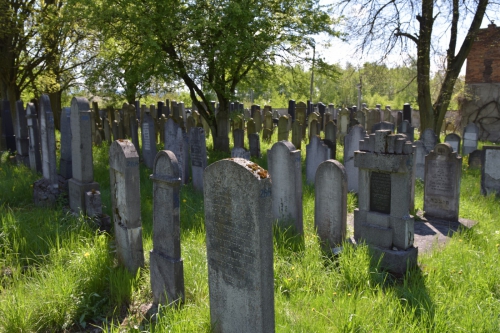Jews were a part of the Wadowice community in the Galician period. Most of them engaged in trade and crafts. In 1880, they constituted over 8% of the total population of the town (404 people), and on the eve of the outbreak of the WWII, approx. 20% (2.000). With the growth of the Jewish community in Wadowice, the Jewish Municipality built a brick synagogue in the style of modern Western synagogues (1885-1889, Gimnazjalna Street, designed by Karol Korn). The Jewish Cemetery was established in 1892, in the neighbourhood of the military cemetery. The Jewish Community had begun efforts for its location as early as 1876. Eventually, some plots right behind the soldiers’ necropolis were purchased. At the entrance gate to the cemetery was a funeral home, Beit Tahara (‘house of purification’). Opposite was the caretaker’s house. The issues of burial were handled by the Wadowice religious organisation Chevra kadisha. Apart from the inhabitants of Wadowice and the neighbouring villages, among those buried here were also soldiers of the Mosaic faith who served at the local garrison or died in any of the local hospitals. During the Great War, 42 soldiers were buried here, most of whom served in Austrian regiments and in the ranks of the Hungarian National Defence; and in 1919-1920 the number was11, mostly from the Bolshevik army.
The cemetery survived the period of German occupation almost intact. After 1945 the cemetery was restored thanks to the efforts of the religious community of Cracow. Currently, it is under the management of the Jewish religious community in Bielsko-Biała. The last burial took place in 1990. Among those resting at the Jewish cemetery in Wadowice it is worthwhile mentioning Baruch Thieberg (deceased in 1902) and Henryk Taub (1898-1919). Baruch Thieberg was a participant of the 1863 January Uprising and the first Jew to settle in Wadowice having escaped from the Kingdom of Poland. Following that event, a rapid influx of Jews to the town began. Henryk Taub was the son of Samuel Taub. After Poland regained independence, he associated himself with the Wadowice 12th Infantry Regiment. As a company commander, he took part in the Polish-Czechoslovak War over the territory of Cieszyn Silesia and Zaolzie where he was wounded with a bayonet thrust to the chest (1919). He was buried at the Jewish cemetery in Orłowa, and in 1939 his remains were brought to Wadowice.

